RUST BELT IN PENNSYLVANIA
PA RUST BELT PAGE 2
PA RUST BELT PAGE 3
PA RUST BELT PAGE 4
On October 7, 1982 the Associated Press reported, "The unemployment rate among steelworkers is 50 percent in the four county Pittsburgh labor market the
state Office of Employment Security reported Tuesday. The state said only half of the steel workers in Allegheny, Beaver, Washington and Westmoreland Counties have jobs
from the peak employment period of July 1979 when 90,000 were working in the mills."
An old slag car is sitting around the ruins of the Duquesne works. The slag from U.S. Steel's Monongahela Valley plants was deposited
at Brown's Dump in West Mifflin, which was later the site for Century III Mall.
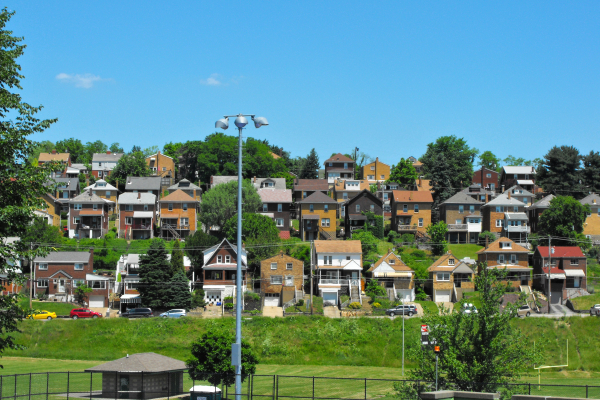
Jun. 2014 image by author
Brookline is one of Pittsburgh's middle class neighborhoods.

Apr. 2008 Google Street View image
Ghost signs on the South Side of Pittsburgh read, "J&L Steel Pittsburgh Warehouse." This historic lettering vanished when new siding was installed.

Feb. 2011 image by author
Old factory buildings along the Allegheny River in Pittsburgh, including Heppenstall Steel, which
closed in 1979. This scene looks completely different now.
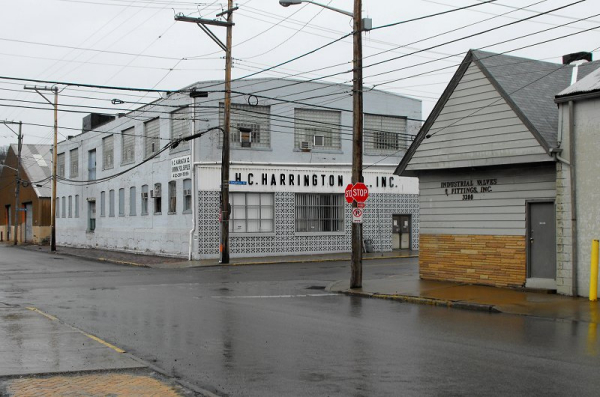
Feb. 2011 image by author
This spot in an industrial neighborhoold of Pittsburgh was once home to the Springfield Foundry Co.

Feb. 2011 image by author
Neighborhood between the Strip District and Lawrenceville sections of Pittsburgh.
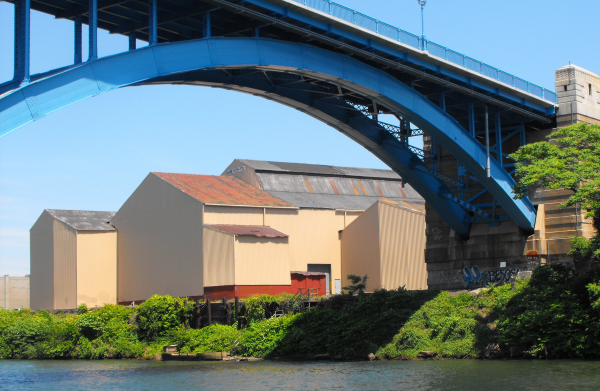
Jul. 2009 image by author
31st Street Bridge and site of former Fort Pitt Iron And Steel Works in Pittsburgh, PA.

Nov. 2004 image by author
Abandoned Armstrong Cork factory in Pittsburgh's strip district. Unbelievably, this dilapidated facility has been renovated into trendy apartments.
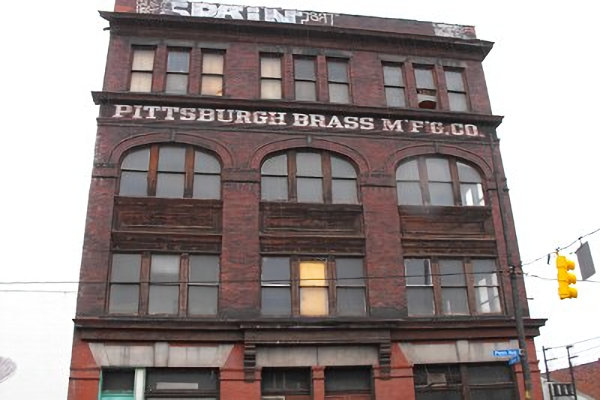
Feb. 2011 image by author
A former brass foundry (Pittsburgh Brass Manufacturing Co.) on Penn Avenue.

Jan. 2006 image by author
One of the largest steel mills that U.S. Steel operated in the Monongahela River valley was at Homestead, PA. This was the scene of the infamous labor war between striking steelworkers and strikebreaking detectives
in 1892. The mill was shut down in the mid 1980s, and today is the site of the Waterfront, a large retail complex. But large smokestacks, a pump house, and this tank remain as a tribute to the workers of U.S. Steel's Homestead Works.

1989 mage by Jack Boucher, Historical American Engineering Record
Overall view of U.S. Steel's Homestead Works as it looked after it was shut down.
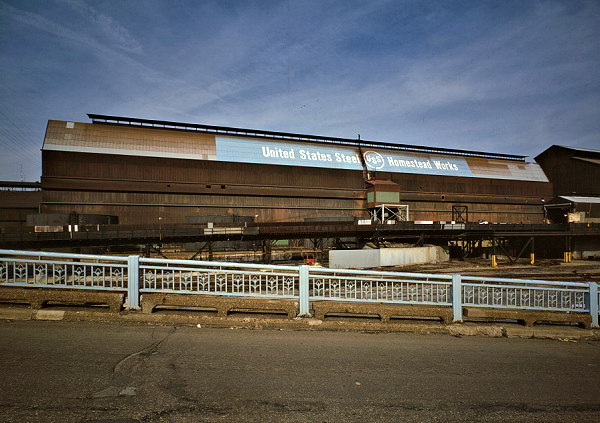
1989 image by Jet Lowe, Historical American Engineering Record
Another photo of the shuttered Homestead steel mill.

1989 image by Martin Stupich, Historical American Engineering Record
Rusty rooftops on the idled Homestead works in one more picture from the late 1980s. In the background is the large slag dump along Nine Mile Run.

Jan. 2006 image by author
The Carrie Furnaces, on the Monongahela River between Rankin and Swissvale, PA, made the hot iron that went across the still existing "Hot Metal Bridge" to the Homestead Works of U.S. Steel. Fortunately, they have escaped the
wrecking ball.

Jan. 2006 image by author
Another view of the Carrie Furnaces, which were constructed around a century ago. On the left is the ore bridge, to the right of that are the furnaces and the draft stack, and on the right is the powerhouse. A portion of the Hot Metal Bridge
rises in the foreground. This is not to be confused with the Hot Metal Bridge down the river at the South Side, which served J&L, not USS.

Sep. 2007 image by author
On the left are Carrie Furnace No. 6 and No. 7 and associated hot blast plant, in front of those sits the coke storage bin, in the lower center is the ore yard, on the right is the ore bridge, and finally the Hot Metal Bridge is in the background.

Sep. 2007 image by author
Valves and plumbing at Carrie Furnaces.

Sep. 2007 image by author
This gentleman, standing in the cast house of Carrie Furnace No. 6, explains the furnace operations to a group on a tour of the furnaces arranged by Rivers of Steel National Heritage Area. These retired steelworkers (or ironworkers) really added color
to the tour, which I enjoyed. He stands next to the hole (arrow) where hot iron flowed into the iron trough.

Sep. 2007 image by author
Coal being barged up the Mon past the Carrie Furnaces, perhaps going to the Clairton Works.

Jan. 2006 image by author
Inscription on St. Mary Croation Roman Catholic Church in Rankin, Pa.

Jan. 2006 image by author
Braddock, PA - a declining Pennsylvania steel town. At least it still has an active steel mill, but the community itself has declined over the years. When John Fetterman was mayor,
he tried different approaches to improve the town.

Jan. 2006 image by author
Looking out over the industrial section of Braddock, with U.S. steel's Edgar Thomson steel mill in the background.

Jan. 2006 image by author
U.S. Steel's Edgar Thomson mill, where the hot iron is turned into steel slabs, to be sent up the river to the Irvin Works.

Jan. 2006 image by author
The Edgar Thomson blast furnaces, the only active blast furnaces remaining in Pennsylvania.

Jan. 2006 image by author
Braddock and North Braddock, PA.

May 2001 image by Beth
I drove past this huge mill building - probably open hearth furnace building - at Duquesne many times without taking a photo. When I finally decided to go down there
with a camera in my hand it was gone. Thankfully, this lady thought to photograph it.

Jan. 2006 image by author
Like tombstones in an industrial graveyard were these ruins of U.S. Steel's blast furnaces at the Duquesne Works, in Duquesne, PA, although not part of the famous Dorthoy Six furnace. U.S. Steel had several blast furnaces with in a few miles of each other in the Monongahela Valley: Carrie, Edgar Thomson, National Tube, and Duquesne. Only the
Edgar Thomson furnaces are still in use. Charlie Hein writes, "I
was born in 1963 and remember driving amongst all of those behemoth steel
mills, thinking they would be there forever - everybody did. I remember
sitting on the steps of a Catholic church across from the Duquense Works
watching and listening to the nonstop work there while my father went to
confession. My dad worked for Koppers Corp. and I remember the
late 1970's and 80's being difficult times for my parents and their friends. I
really still can't believe it's all gone. So, I live in California now but I still drive American!"

Jan. 2006 image by author
The Cowper stoves for the demolished furnaces at Duquesne. These are gone now as well. On May 25, 1984 the Associated Press
reported, "Wearing black arm bands, humming 'Taps' and fighting back tears, grizzled steelworkers toiled their final shift at Dorothy Six, an
award-winning blast furnace whose fires fell victim to the industry's hard times ... 'This arm band symbolizes the death of a blast furnace,
the death of the plant, the death of my job. It's a shame,' said Bob Macey, 35. On his final shift, the 16-year veteran played 'Taps' over the plant's public address
system as his colleagues hummed along. 'My great-grandfather, my grandfather and my father worked in there. That's four generations. It's like
losing everything, like losing your family tree,' said Macey, the contents of his work locker packed into two paper bags he carried home to McKeesport."

Jan. 2006 image by author

Nov. 2003 image by author
U.S. Steel's coke ovens at Clairton, Pa. - opened in 1918, and the largest coke works in the USA. Actually, there was an integrated (coke, iron, steel) steel works
here that was phased out during the 1960s and 70s.

Sep. 2008 image by author
Old coal loadouts across the Monongahela River from USS Clairton Works.

Sep. 2008 image by author
Barges full of coal moored at the Clairton coke plant.

Sep. 2008 image by author
Despite the good paying jobs at the Clairton Works the city's economy is distressed. However, these old storefronts have since been demolished and replaced with a Sheetz.

Feb. 2007 image courtesy Katrencik Photo Archives
Citizens of Clairton, Pa. coexisting with the coke plant.

Sep. 2008 image by author
Part of a concrete plant in West Elizabeth, with Consolidation Coal Company's Marine Ways (for repairing barges of their river fleet) across the river in Elizabeth in the background. Consol
maintained a dock in Elizabeth as far back as 1869.

Sep. 2008 image by author
Mitchell coal fired power plant at Courtney, PA was opened from 1949 until 2013.

Feb. 2007 image by author
Neville Island, in the Ohio River, is an industrial district of Pittsburgh. This is the Kosmos Cement plant at one end of the island.

Feb. 2007 image by author
Shenango, Inc. operated the coke ovens on Neville Island until they were shut down in 2016.

Feb. 2007 image by author
Operations of Shenango, Sunoco Chemicals, and Calgon Carbon were intertwined in this huge industrial complex.

2008 image courtesy of Pittsburgh Independent Media Center
USW Local 5032 picket line in response to lockout at Calgon Carbon. The history of the Rust Belt and of organized labor
are intertwined.

Feb. 2007 image by author
The other side of Neville Island is lined with active and abandoned industrial vendors, warehouses, and bulk material storage yards. The economy of the Ohio River seems to have evolved from
heavy manufacturing to the handling of large commodities like aggregates and scrap for recycling, and now petrochemical products, as well.

Feb. 2007 image by author
Although Neville Island is primarily an industrial district, there is a small residential and commercial section, a portion of which is pictured here.

Feb. 2007 image by author
Abandoned National Electric Products factory in Ambridge, PA.

Feb. 2007 image by author
Ambridge, Pennsylvania in the Upper Ohio Valley was named for the American Bridge subsidiary of U.S. Steel. American Bridge closed their Ambridge shops in 1983.

Feb. 2007 image by author
A.M. Byers Company used to manufacture wrought iron and tools in this large old plant in Ambridge using a Bessemer Converter, which is now on display near Station Square in Pittsburgh.

Image courtesy of Dorsett Studios
The huge J&L steel mill in Aliqiuppa, PA was still standing when this photo was taken of part of it in 1989. Now this is all gone except for the residences. And the population of Aliquippa
has fallen from 27,000 to approximately 12,000.

2013 image by Nick Markowitz
These houses in Aliquippa were probably J&L-built for their employees. When J&L laid out the city they numbered individual neighborhoods as Plan No. 1, Plan No. 2, etc.

Feb. 2007 image by author
J&L Specialty Steel - Midland, PA. Part of the operation was once Crucible Steel Co. Later, this was an Allegheny Technologies (ATI) plant for finishing stainless steel. Allegheny closed
the plant in 2020.

Feb. 2007 image by author
Canonsburg, PA in Washington County.
